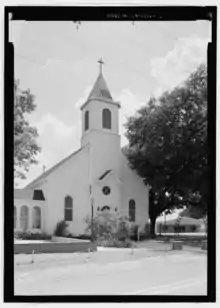Isle Brevelle
Isle Brevelle is a community, which began as a Louisiana Creole settlement and is located in Natchitoches Parish, Louisiana. For many years this area was known as Côte Joyeuse (English: Joyous Coast).
Isle Brevelle | |
|---|---|
Community | |
 | |
| Country | United States |
| State | Louisiana |
| Parish | Natchitoches Parish |
| Time zone | UTC-6 (Central (CST)) |
| • Summer (DST) | UTC-5 (CDT) |

Location
Located in the Natchitoches Parish in Louisiana, in approximately 18,000 acres of land between the Cane River and Bayou Brevelle (near Montrose).[1][2] Two major highways in Isle Brevelle include LA 119 and LA 484.[2]
History
Isle Brevelle is named after Jean Baptiste Brevel, Jr., the 18th century explorer and soldier of the Natchitoches Militia. He is the son of Jean Baptiste Brevelle, a Parisian born trader and explorer, and his Caddo Indian wife, Anne Marie des Cadeaux. Jean Baptiste Brevel Jr. was granted the island by David Pain, the subdelegate at Natchitoches in 1765 for his service to the French and Spanish crowns as a Caddo Indian translator and explorer of Arkansas, Oklahoma, Texas, and New Mexico.[3]
The island is a narrow strip of land some thirty miles in length with three- to four-mile breadth located south of Natchitoches, Louisiana. It is delineated and split by waterways to include the Cane River, Red River, Old River, and Brevelle Bayou (named after Jean Baptiste Brevel). Isle Brevelle was considered "the richest cotton growing portion of the south". Father Yves-Marie LeConiniat, a priest from France, referred to it as an "earthly paradise".[4][5]
As the colony changed hands from France to Spain, the spelling of the Brevel surname changed to Brevelle. Records kept by the Spanish Crown (and later by the United States of America after the Louisiana Purchase) changed the names of the Brevelle family members to reflect the new spelling: Jean Baptiste Brevelle. The Brevelle Plantation grew to become one of the largest plantations in the South producing cotton, tobacco, indigo, lumber, bear grease, cattle, and food crops. [6] [7]
The Louisiana Creole community is made of descendants of French and Spanish colonials, Africans, Native Americans, and Anglo-Americans. [8] [9]
Nicolas Augustin Metoyer (1768–1856), was the son of Marie Thérèse Coincoin and Claude Thomas Pierre Métoyer, and he has been considered the "grandfather" of the community of Isle Brevelle.[10] He was born into slavery and remained in bondage (initially to Don Manuel Antonio de Soto y Bermúdez and wife Marie des Nieges de St. Denis DeSoto)[11] until 1792, at the age of 24.[10] Around this same time his mother, Marie Thérèse Coincoin was also freed from enslavement and they, as a family started collecting local land, which eventually amassed to 6,000 acres.[10] At the center of this collected land was Isle Brevelle.[10] During this era and in this location, mulatto people lived similarly to white Southern planters, in large mansions with expensive furniture, and in some cases they held their own slaves.[10] Nicolas Augustin Metoyer's home no longer stands, but the church he built, St. Augustine Parish still does.[10]
Notable places
- Badin-Roque House
- Coincoin–Prudhomme House (or Maison de Marie Thérèse)
- Melrose Plantation
- St. Augustine Parish
Notable people
- Kellyn LaCour-Conant, restoration ecologist[12]
- Marie Thérèse Metoyer (1742–1816), a planter, former slave turned slave owner, and businesswoman.
- Clementine Hunter (c. 1887–1988), self taught folk artist, she lived at the Melrose Plantation within Isle Brevelle.[13]
- Billie Stroud (1919–2010), self taught folk artist, used Isle Brevelle as one subject of her work and spent time there.[14]
References
- Gregory, H. F. "Isle Brevelle". Louisiana Regional Folklife Program, Northwestern State University.
- "Cane River Creole Community". Louisiana Regional Folklife Program, Northwestern State University.
- Mills, Gary (1977). The Forgotten People: Cane River's Creoles of Color. LSU Press. p. 50-67. ISBN 0807137138.
- McCants, Sister Dorothea Olga (1970). They Came to Louisiana: Letters of a Catholic Mission. LSU Press. p. 122-125. ISBN 0807109037.
- Mills, Gary (1977). The Forgotten People: Cane River's Creoles of Color. LSU Press. p. 51. ISBN 0807137138.
- Vets, Tony (2015). Descendants of Jean Baptiste Brevel: Soldier of Fort St. Jean Baptiste at Natchitoches. CreateSpace Independent Publishing Platform. p. 6-89. ISBN 9781508913740.
- "History Brevelle Conservation Trust". 13 April 2020. Retrieved 2022-05-10.
- "Cane River Creole Community". Retrieved 2022-05-11.
- "History Brevelle Conservation Trust". 13 April 2020. Retrieved 2022-05-10.
- Dowdy, Verdis (21 September 1975). "Discovering Cenla, Grandpere, a Church, and a Portrait". Newspapers.com. The Town Talk. p. 43. Retrieved 2021-06-27.
- Chrysler-Stacy, Elizabeth M. (1994). "Marie des Nieges de St. Denis DeSoto: Mother of De Soto Parish". Louisiana History: The Journal of the Louisiana Historical Association. 35 (3): 350–354. ISSN 0024-6816. JSTOR 4233129.
- "Kellyn LaCour-Conant, MSc Tales from the Trail: Adventures in Restoration Ecology – McWane Science Center". Retrieved 2023-01-08.
- Catlin, Roger. "Self-Taught Artist Clementine Hunter Painted the Bold Hues of Southern Life". Smithsonian Magazine. Retrieved 2021-06-28.
- Register, James (6 January 1974). "Isle Brevelle Produces a New Primitive". Newspapers.com. The Town Talk. p. 29. Retrieved 2021-06-27.